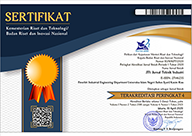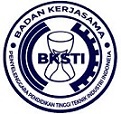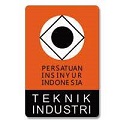Analysis of Body Posture of Rice Processing Warehouse Workers Using OWAS Method (Ovako Working Analysis System)
Abstract
This research assessed the body posture of rice processing workers using the Ovako Working Analysis System (OWAS) method to identify postures leading to high musculoskeletal disorder (MSD) risks. The study observed seven workers in a rice processing warehouse, where 60% of work postures were classified as high-risk (Action Code 4). These postures, frequently involving lifting heavy loads and prolonged bending, significantly contribute to the prevalence of MSD symptoms such as back, arm, and leg pain. Data collection included systematic observation and analysis categorized by OWAS Action Codes. Immediate corrective actions, including ergonomic adjustments and improved training, are essential to mitigate these risks. The findings emphasize the need for ergonomic interventions to enhance worker safety, reduce injury risks, and improve productivity. This research provides valuable insights into the ergonomic challenges in rice processing environments, underlining the importance of regular posture assessments and proactive measures to create safer workplaces.
Keywords: Musculoskeletal, Ovako Working Analysis System, Work posture
Full Text:
PDFReferences
H. A.Cheisario andA. S.Wahyuningsih, “Faktor – Faktor Yang Berhubungan Dengan Terjadinya Keluhan Muskuloskeletal Disorder Pada Pekerja Di PT. X,” Indones. J. Public Heal. Nutr., vol. 2, no. 3, pp. 329–338, 2022, doi: 10.15294/ijphn.v2i3.55016.
W.Anggraini andA. M.Pratama, “Analisis Postur Kerja Dengan Menggunakan Metode Ovako Working Analysis System (Owas) Pada Stasiun Pengepakan Bandela Karet (Studi Kasus Di Pt. Riau Crumb Rubber Factory Pekanbaru),” J. Sains, Teknol. dan Ind., vol. 10, no. 1, pp. 10–18, 2012.
B.Hilman Fauzi, “Mengurangi Kelelahan Otot Dengan Menggunakan Metode OWAS dan REBA (Studi Kasus di CV. Meteor Custom),” J. REKAYASA dan OPTIMASI Sist. Ind., vol. 02, no. 1, pp. 16–21, 2020.
R.Ramisah Alfiani, R.Listyandini, andA.Fathimah, “Faktor-Faktor yang Berhubungan dengan Keluhan Musculoskeletal Disorders (MSDs) pada Penjahit di Pasar Anyar Bogor Tahun 2022,” Promotor, vol. 6, no. 3, pp. 204–212, 2023, doi: 10.32832/pro.v6i3.246.
A.Syukur, “Perancangan Alat Bantu Proses Pemasangan Daun Pintu Menggunakan Metode Verein Deutcher Ingenieure (VDI) 2222.” uin suska riau, 2021.
L.Handoko andH. N.Amrullah, “Pengaruh Faktor Pekerjaan Terhadap Tingkat Risiko Musculoskeletal Disorders (MSDs) Pada Tenaga Kerja di Sektor Pendidikan,” Heal. Res. J., vol. 1, no. 01, pp. 26–34, 2024.
A. J.Nugroho, Tinjauan Produktivitas Dari Sudut Pandang Ergonomi. 2021.
R.Krismanto andA. N.Hidayat, “Identifikasi Risiko Ergonomi Dengan Metode Nordic Body Map Terhadap Operator Final Inspection Di PT. JKLM,” Pros. Sains dan Teknol., vol. 1, no. 1, pp. 589–595, 2022.
M. I. H.Umam, N.Nofirza, M.Rizki, andF. S.Lubis, “Optimalisasi Jumlah Kebutuhan Tenaga Kerja pada Stasiun Kerja Hoisting Crane Menggunakan Metode Work Sampling (Studi Kasus: PT. X),” J. Tek. Ind. J. Has. Penelit. dan Karya Ilm. dalam Bid. Tek. Ind., vol. 5, no. 2, pp. 125–129, 2020.
A.Anwardi, N.Nofirza, andH.Jasri, “Perancangan Alat Bantu Memanen Karet Ergonomis Guna Mengurangi Resiko Musculoskeletal Disorder Menggunakan Metode RULA dan EFD,” J. Tek. Ind. J. Has. Penelit. dan Karya Ilm. dalam Bid. Tek. Ind., vol. 5, no. 2, p. 139, 2020, doi: 10.24014/jti.v5i2.9000.
E.Safira, N.Nofirza, A.Anwardi, H.Harpito, M.Rizki, andN.Nazaruddin, “Evaluation of Human Factors in Redesigning Library Bookshelves for The Blind Using The Ergonomic Function Deployment (EFD) Method,” in Proceedings the 3rd South American International Industrial Engineering and Operations Management Conference, 2022.
E. F.Agustin andR. A.Darajatun, “Analisis Postur Kerja Pekerja Gudang Barang Jadi Menggunakan Metode Ovako Work Posture Analysis System (OWAS) di PT Victorindo Kimiatama,” Go-Integratif J. Tek. Sist. dan Ind., vol. 4, no. 01, pp. 61–75, 2023.
R.Asnel andA.Pratiwi, “Analisis Faktor-Faktor Yang Mempengaruhi Keluhan Musculoskeletal Disorder Pada Pekerja Laundry,” Public Heal. Saf. Int. J., vol. 1, no. 01, pp. 45–53, 2021, doi: 10.55642/phasij.v1i01.23.
M. Y.MF, R.Kurnia, G. D. N.Kusuma, and..., “Studi Risiko Ergonomi dan Keluhan Subjektif Work-Related Musculoskeletal Disorders (WMSDs) pada Penjahit di Kota Tanjungpinang,” … dan Manaj. Ind. …, 2023, [Online]. Available: http://jurnal-tmit.com/index.php/home/article/view/271
N. F.Dewi, “Identifikasi Risiko Ergonomi dengan Metode Nordic Body Map Terhadap Perawat Poli RS X,” J. Sos. Hum. Terap., vol. 2, no. 2, pp. 125–134, 2020, doi: 10.7454/jsht.v2i2.90.
Y. P.Yusdystira, “Recommendations for work posture using nordic body maps and RULA methods,” AIP Conference Proceedings, vol. 2882, no. 1. 2023. doi: 10.1063/5.0176488.
O.Adiyanto, “Application of Nordic Body Map and Rapid Upper Limb Assessment for Assessing Work-related Musculoskeletal Disorders: A case study in Small and Medium Enterprises,” Int. J. Integr. Eng., vol. 14, no. 4, pp. 10–19, 2022, doi: 10.30880/ijie.2022.14.04.002.
M. Z.Gasyanin, “The use of nordic body map and rapid upper limb assessment (RULA) methods in textile companies,” AIP Conference Proceedings, vol. 2882, no. 1. 2023. doi: 10.1063/5.0176487.
N.Nelfiyanti, “Identification of Ergonomic Issues Among Malaysian Automotive Assembly Workers by Using the Nordic Body Map Method,” Lecture Notes in Mechanical Engineering, vol. 46. pp. 69–81, 2021. doi: 10.1007/978-981-15-9505-9_8.
S. F.Zahra andH.Prastawa, “Analisis Keluhan Muskuloskeletal Menggunakan Metode Nordic Body Map (Studi Kasus: Pekerja Area Muat PT Charoen Pokphand Indonesia Semarang),” Ind. Eng. Online J. , vol. 12, pp. 1–9, 2023.
M.Nur, A.Ghallib, A. A.Karim, andR. K.Sari, “Analisis Postur Tubuh Pekerja Unit Finishing Pada Produksi Kertas Menggunakan Metode Ovako Working Analysis System (OWAS),” J. Teknol. dan Manaj. Ind. Terap., vol. 2, no. 4, pp. 278–286, 2023.
D.Kee, “Comparison of OWAS, RULA and REBA for assessing potential work-related musculoskeletal disorders,” Int. J. Ind. Ergon., vol. 83, p. 103140, 2021.
D.Andrian andR.Renilaili, “Pengukuran Tingkat Risiko Ergonomi Dengan Menggunakan Metode Ovako Working Analysis System (OWAS) Untuk Mengurangi Risiko Muscoleskeletal,” Integr. J. Ilm. Tek. Ind., vol. 6, no. 1, p. 32, 2021, doi: 10.32502/js.v6i1.3793.
M. F.Fahmi andD.Widyaningrum, “Analisis Penilaian Postur Kerja Manual Guna Mengurangi Risiko Musculoskeletal Disorders (MSDS) Menggunakan Metode OWAS Pada UD. Anugrah Jaya,” J. Tek. Ind. J. Has. Penelit. dan Karya Ilm. dalam Bid. Tek. Ind., vol. 8, no. 2, pp. 168–174, 2022.
T. I.Oesman andPurwanto, “Penilaian Postur Kerja Guna Evaluasi Tingkat Resiko Kerja Dengan Metode Rapid Office Strain Assessment (Rosa),” J. Tek. Ind. Mesin, Elektro dan Ilmu Komput., pp. 37–42, 2017.
DOI: http://dx.doi.org/10.24014/jti.v10i2.32541
Refbacks
- There are currently no refbacks.
Copyright (c) 2025 Topan Nopanto, Ade Astuti Widi Rahayu, Fathurohman Fathurohman

This work is licensed under a Creative Commons Attribution-NonCommercial-ShareAlike 4.0 International License.
Jurnal Teknik Industri
P-ISSN 2460-898X | E-ISSN 2714-6235
Published by:
Industrial Engineering Department
Universitas Islam Negeri Sultan Syarif Kasim Riau, Indonesia
Office Address:
H.R. Soebrantas KM 15.5, Tampan, Pekanbaru, Riau, Indonesia 28293
email: jti.fst@uin-suska.ac.id
Indexed by:
JTI : Jurnal Teknik Industri under a Creative Commons Attribution-NonCommercial-ShareAlike 4.0 International License.

















